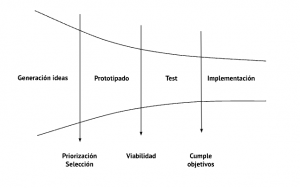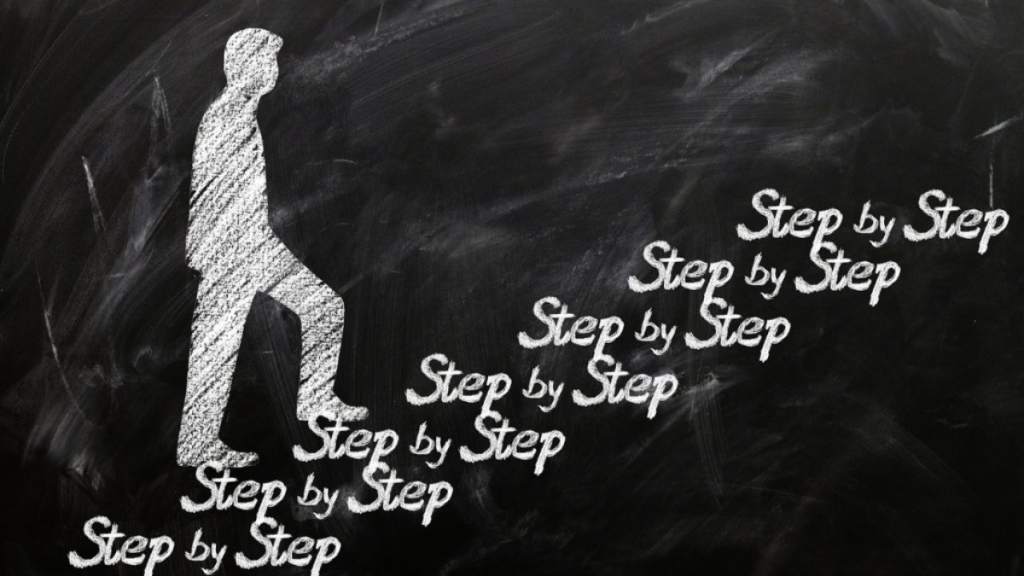No hay innovación sin proceso, metodologías y métricas. Para que la dinámica de innovación sea constante en nuestra empresa, es necesario diseñar y establecer las funciones y el proceso que garantice una ejecución permanente de la búsqueda de ideas, su prototipado y validación y la toma de decisión final en función de indicadores orientados a los objetivos definidos.
A este proceso se le denomina “funnel” o embudo de innovación en el que se identifican las fases, los filtros y los indicadores con los que gestionaremos nuestros proyectos de innovación.
Un ejemplo de embudo podría ser este:

Fase 1 – GENERACIÓN DE IDEAS
Al principio del embudo está nuestro portfolio de ideas que debe contener la mayor cantidad posible de propuestas cubriendo todos los ámbitos de la estrategia que has definido en tu empresa; un portfolio equilibrado de ideas de innovación core, adyacente y transformacional. ¡¡Es la fase más creativa del proceso!!
Filtro 1 – priorización y selección
Fase 2 – PROTOTIPADO
En este momento se da forma a la idea, se convierte en un proyecto y se definen la operativa, los sponsors de negocio y la manera en que se llevará adelante para poder testearlo en un ambiente de prueba.
Filtro 2 – viabilidad del proyecto
Fase 3 – PILOTO
Una primera versión se prueba en un entorno controlado (laboratorio) y se trabaja de manera iterativa sobre ella introduciendo mejoras sucesivas hasta ponerla a punto.
Filtro 3 – cumple objetivos
Fase 3 – IMPLEMENTACIÓN
La innovación se implementa en el entorno real, se replica y escala para generar un verdadero impacto en el negocio.
Para asegurar la calidad de todo el proceso, se deben utilizar métricas no económicas y métricas internas, para las primeras etapas e indicadores financieros duros solo cuando la iniciativa está lista para piloto.
Estas iniciativas son casi siempre a pequeña escala por lo que necesitan pocos fondos. Aun así, es imprescindible, contar con una pequeña bolsa de presupuesto de libre disposición que permita realizar las pruebas necesarias sin la obligación de obtener un retorno a cambio.
FINALMENTE, TODO ESTE PROCESO DEBE SER DIRIGIDO Y EJECUTADO POR UNA PERSONA QUE COMO RESPONSABLE DE LA INNOVACIÓN DE LA COMPAÑÍA, SE ENCARGUE DE:
- Liderar y administrar un amplio portfolio de innovación para potenciar las áreas de negocio de manera transversal.
- Identificar, probar y validar nuevas oportunidades estratégicas a través de metodologías de gestión de la innovación.
- Liderar actividades de exploración para analizar oportunidades de negocio en el ecosistema de innovación.
- Liderar el proceso de innovación entre las partes interesadas en la organización; áreas de negocio, miembros de la junta y los niveles ejecutivos.
- Medir el impacto de la innovación con KPIs y OKR.
AQUÍ TIENES ALGUNOS CONSEJOS PARA QUE UN EMPRENDEDOR PUEDA CREAR UN PROCESO SISTÉMICO DE INNOVACIÓN EN SU EMPRESA:
- Definir una visión clara: Establece una visión clara de lo que deseas lograr a través de la innovación en tu empresa. Define los objetivos y metas que quieres alcanzar y cómo la innovación puede ayudarte a lograrlos.
- Fomentar una cultura de innovación: Crea un entorno en el que se fomente la creatividad, la colaboración y el pensamiento innovador. Anima a tu equipo a proponer ideas y soluciones nuevas, y celebra los éxitos y aprendizajes que surjan de la innovación.
- Establecer un proceso estructurado: Diseña un proceso estructurado que guíe el flujo de ideas, desde la generación hasta la implementación. Define las fases clave del proceso, como la generación de ideas, el prototipado, la validación y la implementación, y establece los filtros y criterios de evaluación para avanzar en cada etapa.
- Involucrar a todo el equipo: La innovación no debe ser responsabilidad exclusiva de un grupo pequeño. Involucra a todo tu equipo en el proceso de innovación, permitiendo que aporten ideas y participen en las diferentes etapas del proceso.
- Establecer métricas de seguimiento: Define indicadores clave de rendimiento (KPIs) para evaluar el éxito de tus iniciativas de innovación. Estas métricas pueden incluir el impacto en los resultados financieros, la satisfacción del cliente, el tiempo de desarrollo de productos, entre otros. Utiliza estas métricas para tomar decisiones informadas y ajustar tu enfoque de innovación.
- Promover la colaboración externa: Explora oportunidades de colaboración con socios externos, como startups, universidades o expertos en la industria. Estas colaboraciones pueden aportar nuevas perspectivas, conocimientos especializados y acceso a recursos adicionales para impulsar la innovación en tu empresa.
- Aprender y adaptar continuamente: La innovación es un proceso iterativo. Aprende de los éxitos y fracasos, y utiliza esos conocimientos para mejorar continuamente tus iniciativas de innovación. Mantente abierto a los cambios y adapta tu enfoque según las necesidades y oportunidades que surjan.
Recuerda que cada empresa es única, por lo que es importante adaptar estos consejos a tu contexto específico. La clave está en construir un proceso de innovación que se alinee con los objetivos y la cultura de tu empresa, fomentando la creatividad y la colaboración en busca de soluciones disruptivas y mejoras constantes.
LA INTELIGENCIA ARTIFICIAL (VER+ TIP) PUEDE AYUDARTE EN LA CREACIÓN DE UN PROCESO SISTÉMICO DE INNOVACIÓN EN UNA NUEVA EMPRESA DE LAS SIGUIENTES MANERAS:
- Generación de ideas: Puedes utilizar la inteligencia artificial para generar ideas creativas y novedosas que impulsen la innovación en tu empresa. Proporciona información sobre tu industria, mercado y desafíos específicos, y la inteligencia artificial puede ofrecerte diferentes enfoques y soluciones que podrías considerar.
- Diseño de procesos: la inteligencia artificial puede ayudarte a diseñar un proceso estructurado de innovación adaptado a las necesidades de tu empresa. Puedes solicitar recomendaciones sobre las fases clave, los métodos de selección de ideas, los criterios de evaluación y los mecanismos de implementación. La inteligencia artificial también puede ayudarte a identificar las mejores prácticas utilizadas en otras organizaciones.
- Análisis de datos: La innovación basada en datos es crucial para el éxito de cualquier proceso de innovación. Puedes utilizar la inteligencia artificial para analizar datos relevantes, como información de mercado, tendencias de la industria, retroalimentación de los clientes, entre otros. Esto te permitirá tomar decisiones informadas y respaldadas por datos en el proceso de innovación.
- Evaluación de viabilidad: Antes de invertir recursos en una idea de innovación, es importante evaluar su viabilidad. La inteligencia artificial puede ayudarte a analizar los aspectos técnicos, económicos y estratégicos de una idea, así como a identificar posibles obstáculos o riesgos asociados. Esto te permitirá tomar decisiones más fundamentadas sobre qué ideas priorizar.
- Mejora continua: La inteligencia artificial puede ser utilizado como una herramienta de aprendizaje constante en la mejora continua de tu proceso de innovación. Puedes compartir los resultados y el desempeño de tus iniciativas de innovación con la inteligencia artificial para obtener sugerencias y recomendaciones sobre cómo optimizar y perfeccionar tu enfoque.
Recuerda que la inteligencia artificial es una herramienta basada en el lenguaje y que sus respuestas se generan en función de los datos con los que ha sido entrenado. Siempre es importante complementar la información y las ideas proporcionadas por la inteligencia artificial con el conocimiento y la experiencia humanos, así como con una evaluación crítica de la viabilidad y adecuación de las soluciones propuestas.
CASO PRÁCTICO DEL PROCESO SISTÉMICO DE INNOVACIÓN
Empresa: ABC Tech, una empresa de desarrollo de software.
FASE 1 – GENERACIÓN DE IDEAS
- Se realiza una lluvia de ideas con el equipo de desarrollo para identificar posibles áreas de innovación en el ámbito de aplicaciones móviles.
- Se generan ideas como una aplicación de realidad aumentada para el sector turístico y una plataforma de gestión de citas médicas en línea.
FILTRO 1 – PRIORIZACIÓN Y SELECCIÓN:
- Se realiza un análisis de viabilidad y potencial de cada idea.
- Se decide priorizar la idea de la plataforma de gestión de citas médicas debido a la creciente demanda en el sector de la salud y la oportunidad de negocio asociada.
FASE 2 – PROTOTIPADO
- – Se forma un equipo multidisciplinario para desarrollar el prototipo de la plataforma de gestión de citas médicas.
- – Se definen los aspectos operativos, como la interfaz de usuario, el flujo de reserva de citas y la integración con sistemas de gestión de clínicas.
FILTRO 2 – VIABILIDAD DEL PROYECTO
- Se evalúa la viabilidad técnica y los recursos necesarios para llevar a cabo el proyecto.
- Se confirma la viabilidad y se procede a la siguiente fase.
FASE 3 – PILOTO
- Se realiza una prueba piloto de la plataforma en una clínica de salud local.
- Se recopilan comentarios y se realizan ajustes en base a la retroalimentación de los usuarios y el personal de la clínica.
FILTRO 3 – CUMPLE OBJETIVOS
- Se evalúa si la plataforma cumple con los objetivos establecidos, como la eficiencia en la gestión de citas, la mejora en la experiencia del paciente y el impacto en la productividad de la clínica.
- La plataforma supera las expectativas y se considera listo para la implementación a mayor escala.
FASE 4 – IMPLEMENTACIÓN
- Se implementa la plataforma de gestión de citas médicas en múltiples clínicas y se realiza un plan de marketing para promover su uso entre los pacientes.
- Se monitorea el rendimiento y se realizan ajustes adicionales según sea necesario.
Este ejemplo ilustra cómo el proceso sistémico de innovación se aplica en el desarrollo y lanzamiento de una plataforma de gestión de citas médicas. Cada fase del embudo de innovación se enfoca en la generación de ideas, la selección de proyectos viables y su implementación exitosa en el mercado.







